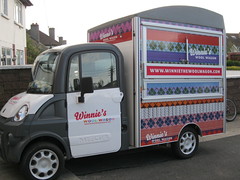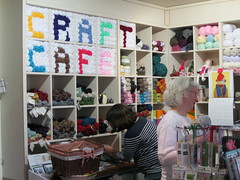ee One could be excused for wondering if any actual knitting got done on the Irish Knitting Tour when reading these blog posts. Well the answer is that yes, some of us got a fair amount accomplished but there were also games of bridge, pints of Guinness, glasses of Jameson's, shopping and just some good ol' chin wagging that had to be accomplished as well.
Here are some pictures to prove that I did take my knitting quite seriously while I was there. This is the lower body of a jacket that I'm making for my sister-in-law who turns 50 next summer. Those of you who follow this blog may remember that I have committed to knit each of my siblings and their spouses a sweater for their 50th birthday. As my youngest brother turns 50 in Dec. 2012, and he is 6'5", I decided that I would try and get a head start on his wife's sweater as his will probably take me a good long time.
I also brought one of the kits that we had in the store for one of my favourite patterns: The Ridged Baktus Scarf. I chose this one because the colours were just so darn Irish. It is made of 2 different bamboo yarns and I had not have much chance to knit with bamboo. I'm loving it, and although I'm not sure what I'm going to do with this particular scarf I might just keep it as a souvenir of these 10 days on the Emerald Isle.
On our last morning in Dublin Abbey Tours, who had done such a wonderful job of organizing all of our travel, had set up a fabulous workshop at Winnie's Craft Cafe with Pauline Gallagher to teach us the basics of Irish/Aran knitting through her pattern for the Oisin Owl (pronounced Osheen owl) which can be found on Ravelry.
Pauline's handout has an absolutely fabulous history of the Aran sweater, showing how inaccuracies and creative interpretation of half known facts lead to a world of "Blarney". It is so good and concise that our guide, Gerry asked at the front desk of our hotel to make a copy. The front office manager was so impressed that he also made a copy for himself, as he said he was never sure what to tell people when asked about the truth about these gorgeous but often misrepresented garments.
 Although all of our members look like are very dilligently at work in the picture here, what you may not notice right away is the EAT sign in the back. Just to the left of this picture is actually the most magnificent array of baked goods that you can imagine, and we were all treated to a tea/coffee and traditional scone as part of the workshop. We just felt so spoiled. After all of this wonderful knitting activity everyone got to go into the store part of Winnie's Craft Cafe to do a little shopping.
Although all of our members look like are very dilligently at work in the picture here, what you may not notice right away is the EAT sign in the back. Just to the left of this picture is actually the most magnificent array of baked goods that you can imagine, and we were all treated to a tea/coffee and traditional scone as part of the workshop. We just felt so spoiled. After all of this wonderful knitting activity everyone got to go into the store part of Winnie's Craft Cafe to do a little shopping. Marina Hand (in white) is the owner of Winnie's. An accountant who, by virtue of the recession, was forced to make some life changes and difficult choices and now finds herself having the time of her life greeting people and helping lots of young mom's and others who come in to sit at the cafe and work on their knitting projects.
I had assumed that there was a human Winnie involved in this story somewhere but was surprised to learn from the website that Winnie has an interesting history herself:
Meet WINNIE, the Wool Wagon. Winnie lives outside the Craft Cafe in Booterstown district of Dublin. Winnie, the wagon originally came to help Marina in her effort to bring beautiful wools and other yarns to the masses in local fairs and markets. She and Marina have now found a lovely home together, serving the knitters of Dublin.
Winnie lives outside the Craft Cafe in Booterstown district of Dublin. Winnie, the wagon originally came to help Marina in her effort to bring beautiful wools and other yarns to the masses in local fairs and markets. She and Marina have now found a lovely home together, serving the knitters of Dublin. Before I leave my tales of Dublin and Ireland, I must tell you of my most amazing discovery. On the first day of the tour I heard someone mention Tim Hortons. Gerry, the guide asked nonchalantely: "Oh, do you have Tim Hortons in Canada?" I couldn't understand the question, it seemed so odd. Then we discovered that "SPAR", the Irish equivalent of Mac's Milk, has a coffee service in many of their stores that is supplied by Tim Hortons. This one happens to be in the SPAR store just next to Winnie's, and having been so royally treated to goodies at their cafe, I didn't get a chance to try it, but I'm told that it's just like home.
Before I leave my tales of Dublin and Ireland, I must tell you of my most amazing discovery. On the first day of the tour I heard someone mention Tim Hortons. Gerry, the guide asked nonchalantely: "Oh, do you have Tim Hortons in Canada?" I couldn't understand the question, it seemed so odd. Then we discovered that "SPAR", the Irish equivalent of Mac's Milk, has a coffee service in many of their stores that is supplied by Tim Hortons. This one happens to be in the SPAR store just next to Winnie's, and having been so royally treated to goodies at their cafe, I didn't get a chance to try it, but I'm told that it's just like home.
So on Wednesday evening we were driven to the Abbey Tavern for an evening of traditional Irish food and entertainment. We returned to the hotel with way too much packing and organizing to do. But all got attended to and somehow all 32 of us managed, with our guide, Gerry and our faithful bus driver, John to line up for one last group picture. I'm almost reticent to see that picture as it was such a bittersweet time of parting.
It's funny. My nature and my personality is that I'm always up for the next thing. I love change, I love new things. Yet, this was a hard goodbye to a land that is struggling in the face of grave economic uncertainty with a brave and willing smile. It was an honour to have spent this time in such a wonderful land and with such a rich and resillient group of people.
























